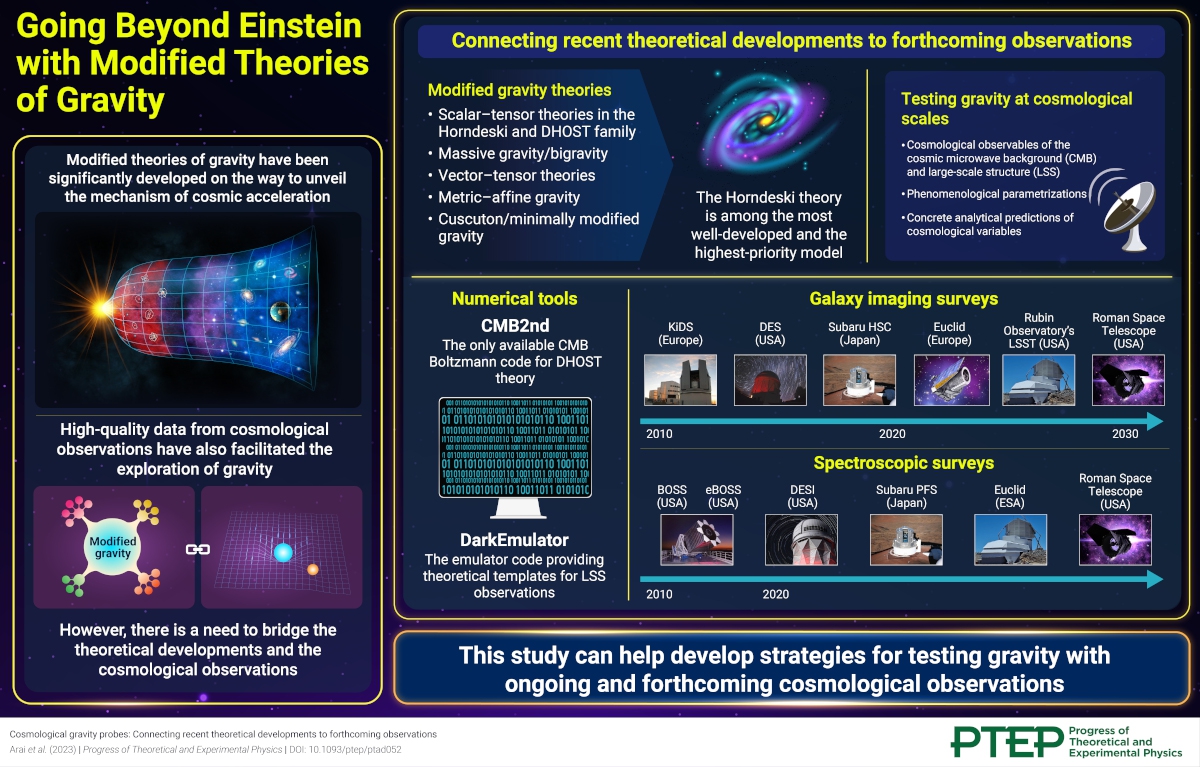Going Beyond Einstein with Modified Theories of Gravity
© The Physical Society of Japan
This article is on
Cosmological gravity probes: Connecting recent theoretical developments to forthcoming observations
(PTEP Invited Paper)
Prog. Theor. Exp. Phys.
2023,
072E01
(2023)
.
This study comprehends a way to probe modified theories of gravity on cosmological scales by combining theoretical advancements and observational data for upcoming cosmological observations.

In the past two decades, physicists have made significant progress in the field of cosmology, thanks to precise measurements of the properties of the cosmic microwave background (CMB) and large-scale structure (LSS) of the Universe. The prevailing Λ-cold-dark-matter model, which describes the late-time Universe, has been successful in explaining the interplay of cosmic expansion and structure formation. However, it is not without its limitations. One notable challenge is the fine-tuning required to accommodate the observed value of the cosmological constant, necessitating new developments. Meanwhile, physicists have turned their attention to modified theories of gravity.
By modifying Einstein's theory of general relativity (GR) on cosmological scales, they aim to uncover alternative explanations for cosmic acceleration. While GR has proven its accuracy for small-scale tests, its validity on cosmological scales remains uncertain. Thus, probing gravity at these large scales is crucial for understanding the late-time evolution of the Universe.
In this study, we provide a comprehensive overview of various modified theories of gravity, including scalar-tensor theories in the Horndeski and DHOST family, massive gravity/bigravity, vector-tensor theories, and more of what we have theoretically known. We then highlight cosmological observables of the CMB and LSS and present concrete analytical predictions from well-motivated theories to shed light on their potential deviations from GR.
To further theoretical predictions, we introduce computational tools, such as the CMB Boltzmann code for DHOST theory and emulator codes for LSS observations. Such tools are instrumental in assessing the behavior of gravity models in the nonlinear regime.
Lastly, we highlight the scope of future cosmological observations that hold the key to unraveling the mysteries of gravity. Ground-based CMB experiments, such as the Simons Observatory and the CMB Stage 4 observatory, along with space missions like the LiteBIRD satellite, are anticipated to provide high-quality data for testing gravity at large scales. Additionally, upcoming observations in LSS, including the Subaru Prime Focus Spectroscopy (PFS), the Vera C. Rubin Observatory (LSST), and the Nancy Grace Roman Space Telescope, among others, will offer valuable insights into the evolution of cosmic structures.
By prioritizing well-developed models of gravity like the Horndeski theory, which is the highest-priority model for formulating an observational strategy, physicists can refine their theoretical predictions, address remaining challenges, and ultimately test these models with precise cosmological observations.
Overall, this work emphasizes the need for collaborative efforts encompassing theoretical advancements, forthcoming observations, and computational implementations to advance our understanding of gravity at cosmological scales.
Indeed, by unveiling the mysteries of the cosmos, we inch closer to comprehending the fundamental nature of our vast and awe-inspiring Universe.
Cosmological gravity probes: Connecting recent theoretical developments to forthcoming observations
(PTEP Invited Paper)
Prog. Theor. Exp. Phys.
2023,
072E01
(2023)
.
Share this topic
Fields
Related Articles
-
LiteBIRD: A New Frontier in the Search of Cosmic Inflation Imprint
Astrophysics, cosmology, and geophysics
2023-3-22
The newly selected LiteBIRD satellite aims to detect cosmic inflation signals by identifying the imprint of primordial gravitational waves in the Cosmic Microwave Background polarization.
-
A New Look at Our Universe with Gravitational Wave Astronomy
Astrophysics, cosmology, and geophysics
2021-10-26
A new interdisciplinary collaborative project underscores the importance of combining theory with advanced observation techniques to understand gravitational waves and their sources, opening doors to new discoveries about the universe.
-
Designing a New Space-borne Interferometer to Probe the History of Our Universe
Astrophysics, cosmology, and geophysics
2021-9-22
Scientists present a new design for a space-born laser interferometer that could detect gravitational waves below 10 Hz, letting us probe into new astrophysical phenomena.




